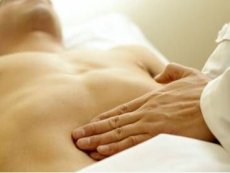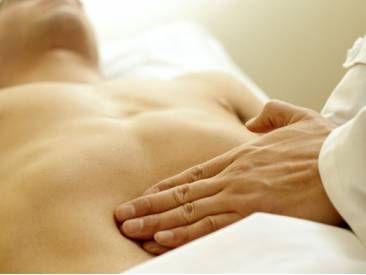Pain in the stomach after eating
Last reviewed: 23.04.2024

All iLive content is medically reviewed or fact checked to ensure as much factual accuracy as possible.
We have strict sourcing guidelines and only link to reputable media sites, academic research institutions and, whenever possible, medically peer reviewed studies. Note that the numbers in parentheses ([1], [2], etc.) are clickable links to these studies.
If you feel that any of our content is inaccurate, out-of-date, or otherwise questionable, please select it and press Ctrl + Enter.

Gastroenterologists often take patients who complain of stomach pain after eating. Although no significant problems were found with these people, such complaints deserve a serious medical examination. It is especially important to investigate this symptom in the elderly, because the incidence of stomach cancer increases with age.

Causes of pain in the stomach after eating
One of the most poorly studied and unpredictable organs is our stomach. It is the central organ of digestion, which is responsible for digesting food. This organ of the digestive system can often react to our bad habits, such as poor water, unhealthy foods, too abundant dishes, etc. However, the stomach still manages to digest all this when he begins to protest. In the end, it leads to stomach pain after eating. This pain can change its nature depending on the cause.
Sometimes a person can feel pain in the stomach after eating. The reasons may be:
- Food intolerance
- Appendicitis
- Stones in the gallbladder
- Pancreatitis
- Heartburn
- Improper intake of food and water
- Binge eating
- Stomach ulcer
Food intolerance
This is the most likely cause of stomach pain after taking certain dishes. Pain can develop if you are allergic to any food. Maintaining a food diary is the best way to identify products that cause such symptoms. Describe in detail in this diary the food that you eat during the day. In a few days you will be able to determine which product or type of food leads to health problems. Like stomach pain, bloating after taking dairy products, usually arises from lactose intolerance.
Food poisoning
Another possible cause of stomach pain after eating can be food poisoning. In this case, you will experience severe pain in the stomach shortly after eating.
Typical symptoms include nausea, vomiting, abdominal cramps and diarrhea that occur suddenly (within 48 hours) after consuming poor-quality food or drink. Depending on the toxins that are contained in food, a person may have fever and chills, bloody stools, dehydration and nervous system disorders. These symptoms can be in one person or a group of people who ate the same dish.
Appendicitis
Intensive pain in the stomach and lower right side of the stomach after eating can be caused by appendicitis. They can also be accompanied by nausea, vomiting, or a slight increase in temperature. Urgently call a doctor if you experience these symptoms along with stomach pain after eating.
Stones in the gallbladder
The gallbladder is a small pear-shaped sac located below the liver in the right upper abdomen. The stones in it are formed when the bile, which is stored in the gallbladder, hardens.
Bile contains water, cholesterol, fats, bile salts, proteins and bilirubin waste. Bilirubin gives bile and feces a tan color. If the bile contains too much cholesterol, bile salts or bilirubin, it can harden to the state of gallstones.
There are two types of gallstones - cholesterol stones and pigmented stones. Cholesterol stones are usually yellow-green and consist mainly of hardened cholesterol. They account for about 80 percent of all gallstones. Pigmentary stones are small, they are dark, because they are made of bilirubin. Stones can be the size of a grain of sand or as large as a golf ball. In the gall bladder, only one large stone can grow, or hundreds of small stones, or their combinations.
Pain in the stomach after eating in the upper right corner is a symptom of stones in the gallbladder. Pain in this area is often given to the right upper back, right shoulder and chest.
Pancreatitis
Burning and severe pain in the upper abdomen, stomach pain that occurs immediately after eating, or pain that does not stop six to twelve hours after a heavy meal, can be caused by pancreatitis. This pain often begins to bother in the upper abdomen and spreads to the right and left sides or lower back. It can be accompanied by nausea, palpitations or fever.
Moderate spasms in the stomach after eating, accompanied by vomiting, which has the smell of stools, is one of the characteristic symptoms of intestinal obstruction. Other symptoms of intestinal obstruction include loose stools or complete absence. Severe stomach cramps can be accompanied by pain in the left lower abdomen - often these are the symptoms of diverticulitis.
Heartburn
Heartburn is another common cause of stomach pain. The pain in the stomach with bloating immediately after eating is supplemented by a characteristic symptom: less than three bowel movements a week and a stiff chair that looks like a stool with constipation. Constipation arises from the lack of fiber in the diet. The infrequent use of water during the day makes an additional contribution to this health problem. The feeling of fatigue after eating, as well as bloating and stomach pain after eating is a symptom of heartburn and irritated bowels.
Improper intake of food and water
Pain in the abdomen can be caused by the use of a large amount of fluid immediately after eating. Drinking water, fresh fruit juices, soft drinks or any other drinks immediately after meals dilute the stomach acids. The correct concentration of gastric juice helps to kill harmful bacteria in food and keeps your digestive system healthy. When the stomach acid is diluted, the food is digested hard. In addition, harmful bacteria are not eliminated, and then your body tries to pluck out the food, which leads to stomach upset.
Such a regimen can lead to diarrhea after eating. Infection caused by bacteria or viruses can also lead to stomach pain immediately after ingestion. When bacteria or viruses enter the body, the body reacts negatively to them and tries to get rid of the infection through diarrhea or vomiting. Nausea after eating is very common in this case. Pain in the stomach, along with nausea, is also a symptom of gastritis.
Binge eating
Overeating or too fast consumption of food often leads to abdominal pain, so try to curb your appetite. In addition, if you keep your stomach empty for a long time and then eat an unbroken amount of food at a time, it can cause stomach pain after eating. To avoid this, moderation in the diet is very important. Follow the diet and stick to a healthy diet. Drink liquid throughout the day, but avoid drinking water for half an hour after eating. Avoid eating unhealthy foods. Walking is the best remedy after a meal that will help ensure proper digestion of food.
Gastric ulcer and other problems
Remember that stomach pain after eating can be a symptom of serious problems, such as perforated stomach ulcers, heart attacks and many other minor or major health problems mentioned above. If the pain does not subside, be sure to see a doctor. Make sure the doctor has made the most detailed diagnosis if the problem of stomach pain has been tested repeatedly.
Who to contact?
Who should I contact if you have stomach pain after eating?
Remember that the pain in the stomach after a meal can be a serious problem, so you need to treat it with all attention, by contacting a gastroenterologist or therapist.


 [
[